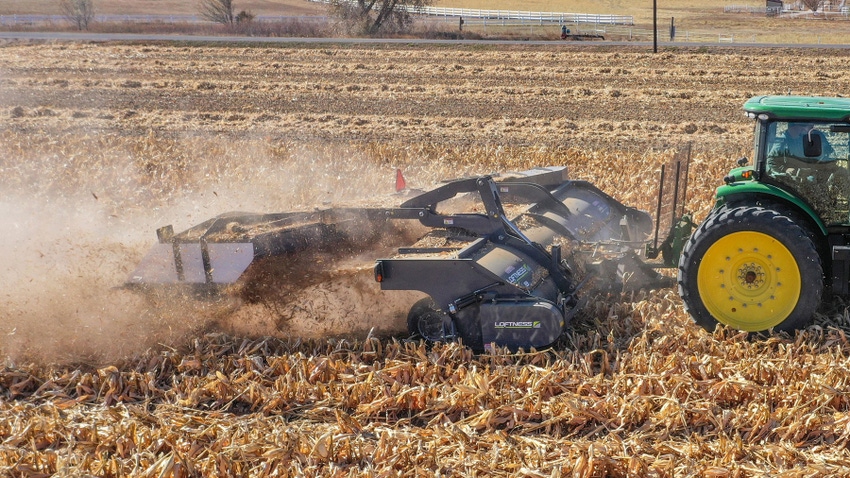April 9, 2024

Looking for a better way to move a crop through a windrower? Loftness has developed an air-powered unit that can efficiently move forages. Its new side-discharge crop shredder doesn’t rely on a mechanical belt-and-auger system. Instead, the 20-foot-long machine uses the air displaced by the blades to move the chopped crop into a windrow, says Tryg Waterhouse, director of sales at Loftness.
Traditional windrowers rely on mechanical means to move residue along a conveyor belt to be deposited onto the ground. Their reliance on mechanical mechanisms makes them prone to plugging and breakdowns, Waterhouse says. They also require more maintenance.
In contrast, Loftness’ side-discharge shredder is “significantly less prone to plugging, like you get with an auger,” he says. “We can pull this windrower in a lot of cases quite a bit faster than what you can pull with a belt or auger style because the material can be moved a lot faster.”
Citing in-house comparison tests, Waterhouse says Loftness’ windrower can be pulled at 6.5 to 7 mph, around double that of a mechanical machine. It has a patent-pending angled wing affixed behind the shredder that catches the residue in a vortex.
The suspended material is carried through the wing’s length until it is diverted downward by a “diffuser” at the end. Because the crop is discharged to the side, the operator can combine 40 feet of crop into one windrow with two field passes.
The two passes placing twice the material in one windrow increases efficiency during baling, Waterhouse says. Its ability to double-up windrows makes it a good fit for low- to medium-yield applications, primarily in corn.
Other standard features include:
adjustable wheels to match row spacing
hydraulic rear lift for precise height adjustment
folding wing design for storage and transport
The machine is powered by a reliable four-groove banded belt drive and a heavy-duty gearbox rated at 280 hp. An optional transport system is available for narrow transport between fields.
Take a look inside
Here’s how it works: Inside a drum, the windrower’s rotary flail knives spin at 1,500 rpm. Its cupped design creates suction.
“Not only does it cut the crop at the desired height, but it also moves air because of its shape and orientation,” Waterhouse says. “It’s essentially like a big fan.”
Its design is based on Loftness’ center-discharge crop shredder, which leverages air movement to create windrows. Compared to the center-discharge shredder, however, the side-discharge machine required a more specific wing design.
“A lot of that development was around designing and patenting the shape of the wing to keep that air moving fast enough and in suspension all the way down to the end,” Waterhouse says, adding that “20 feet is a long distance to keep material in suspension.”
Crop quality and weather impact the machine’s effectiveness. It won’t work with heavy, wet material because the vortex isn’t strong enough to keep it in suspension.
“In really windy conditions, it’s a two-part problem,” Waterhouse says. Wind speed and orientation relative to the crop shredder impacts “the efficiency of the vortex. If the wind is blowing really hard right up the shoot of the windrower, it won’t create a vortex efficiently.”
The standard base model costs $70,624. Dealers are taking orders. Five windrowers are already being used in North American fields.
About the Author(s)
You May Also Like






